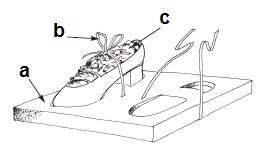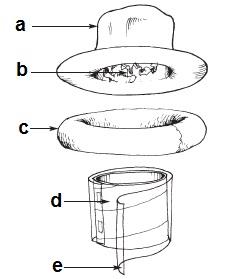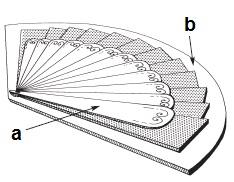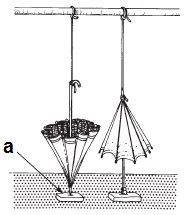Storage for Costume Accessories – Canadian Conservation Institute (CCI) Notes 13/12
(PDF Version, 922 KB)
CCI Note 13/12 is part of CCI Notes Series 13 (Textiles and Fibres)
Introduction
A costume accessory is an item such as a hat that is worn with a costume, but is not necessarily part of the costume. Accessories are usually stored on shelves or in drawers (CCI Notes 13/2 Flat Storage for Textiles) and with some form of interior support. The items selected to illustrate storage methods in this Note are typical of the accessories found in most costume collections.
Recommended support materials are unbuffered, acid-free (neutral pH) tissue paper, washed unbleached cotton, polyester fibrefill, cotton knit fabric, polypropylene foam sheet (Microfoam), polyethylene foam sheet (Ethafoam, Polyfoam), and extruded plank Styrofoam.
Environment
Most materials found in costume accessories can be safely stored at a relative humidity (RH) between 45 and 55%. As with all collections, fluctuations in RH should be kept to a minimum. Temperatures should not exceed 21°C (CCI Notes 13/1 Textiles and the Environment). Information on measuring environmental conditions can be obtained from CCI Notes 2/4 Environmental Monitoring Kit (retired).
Many components of costume accessories are highly light-sensitive. Dyed and coloured materials are particularly prone to irreversible fading or change in colour when exposed to light. Therefore, as far as possible, all costume accessories should be stored in the dark. When they are exposed to light, the light level should be kept below 50 lux with an ultraviolet component of less than 75 µW/lm.
The importance of good housekeeping in storage areas cannot be overstressed. Dust and dirt can disfigure and damage textiles both physically and chemically, and should be removed from the accessory before it is stored. Objects should also be protected from dust and dirt while in storage. A thorough inspection for insect infestation should be made at least every 6 months, and more frequently if possible (CCI Notes 3/1 Preventing Infestations: Control Strategies and Detection Methods).
All types of costume accessories benefit from having an individual storage mount. Such mounts eliminate direct handling of the artifact and can be clearly labelled with the accession number to facilitate locating a particular item.
Instructions
To pad accessories, use unbuffered acid-free tissue paper with a neutral pH.
Shoes
To retain the original shape of a shoe as closely as possible, pad the interior with acid-free tissue paper, polyethylene foam covered with knit fabric, or a cotton stockinette tube filled with polyester or cotton quilt batting. Store shoes either in a closed unit or on open shelving protected by dust covers. Arrange shoes standing side-by-side. Identify each shoe with a tag. Do not permit shoes to touch each other. Never stack shoes because this could cause soiling, cracking (especially of patent leather), and deformation.
Shoes can also be placed in a block of polyethylene foam with the contours of the heel and sole carved into the foam. Cotton tape can be used to further secure the shoes to the block (Figure 1). A piece of corrugated polypropylene/polyethylene can also be used. In this case, in addition to the cotton tape ties, polyethylene foam blocks should be adhered in front of the toes and behind the heels to prevent slippage. Alternatively, the foam blocks can be placed in commercially available, acid-free cardboard trays/boxes, custom-made corrugated polypropylene/polyethylene trays/ boxes (Coroplast, Cor-X), or commercially moulded polypropylene/polyethylene storage containers to provide further protection for the shoes and to limit unnecessary handling.

b, cotton twill tape tie; c, acid-free tissue paper.
Bonnets and hats
Bonnets and hats must be fully supported, including crowns, brims, neck shields, etc. Styrofoam head forms give the best and most uniform support to the crown. Be sure the form is the proper size. It should receive the hat easily without force, and be tall enough to raise the hat slightly off the shelf. If the form is too small, enlarge it to the required size using acid-free tissue paper; if it is too large, carve it down to the appropriate size. Cover the form with a sheet of acid-free tissue paper or with a prewashed, white, cotton-knit fabric. When the hat is in position on the form, place a roll of crumpled acid-free tissue paper or a ring of tubular stockinette filled with polyester batting under the brim so that it is fully supported.
If Styrofoam heads are not available, a short length of sturdy cardboard tube covered with a barrier such as Mylar can be used to form a stand. The bonnet or hat must be well-lined with crumpled acid-free tissue paper before being placed over the tube. Pad hats without brims with enough acid-free tissue paper to support the shape, to eliminate folds, and to raise the edge of the hat off the shelf.

c, tubular stockinette ring; d, cardboard tube; e, barrier.
Purses
Fill purses loosely with crumpled acid-free tissue paper so that they assume their correct shape. Store them flat, out of contact with other objects, and with handles straightened and supported. Move purses by supporting the whole bag rather than by using the fragile handles.
Gloves
Most gloves can be laid flat on polypropylene foam sheet or on sheets of acid-free tissue paper. A particularly delicate pair of gloves (e.g. with evidence of cracking or splitting leather or fibre weakness) requires interior support where feasible. To achieve this, roll small pieces of acid-free tissue paper into thin tubes and, using extreme caution, insert them into the fingers of the gloves. Use small pieces of loosely crumpled acid-free tissue paper for the remainder of the glove. Stop if any further splitting occurs.
Fans
Ideally, both rigid and folding fans should be laid on supports of polyethylene foam sheet (2 cm thick) cut 5 cm larger all around than the fan. Open folding fans enough to show the decoration without placing strain on the ribs. Very fragile fans should be protected and supported in a form made of polyethylene foam sheeting (Figure 3). In the absence of rigid support material, lay fans on polypropylene foam or on sheets of acid-free tissue paper. If the fan must be moved, lift it by the support.

Parasols
Because of their shape, parasols in sound condition should be stored vertically (Figure 4). To suspend parasols, insert a dowel rod into the end walls of a storage cabinet. The distance from the rod to the shelf should be 25 cm greater than the longest parasol in the collection. To store the parasol, open it partially and tie cotton tape to one end (either the handle or the tip of the central stem) and then around the rod. Place a polyethylene foam block with a small central recess under the parasol to keep it in place. Correct the position of the parasol by adjusting the tape so that the parasol rests lightly on the block. When parasols are suspended by their handles, support the fabric folds by inserting cones of rolled acid-free tissue paper. If a parasol is damaged (e.g. weakened or broken handle, centre stem, or spokes; missing parts; torn fabric), store it closed. Wrap it in acid-free tissue paper, tie it loosely with cotton tape, and place it horizontally.

Suppliers
Note: The following information is provided only to assist the reader. Inclusion of a company in this list does not in any way imply endorsement by the Canadian Conservation Institute.
Unbuffered, acid-free (neutral pH) tissue paper:
Conservation supply houses
Cotton tape:
Fabric stores
Styrofoam heads:
Suppliers of display materials, hair salons, wig suppliers
Rigid polyethylene foam (e.g. Ethafoam):
Polypropylene foam (e.g. Microfoam):
DuPont Global Headquarters (manufacturer)
Canadian Paper & Packaging Co. Ltd. (distributor)
Bibliography
Barclay, R., A. Bergeron, and C. Dignard. Mount-making for Museum Objects, second edition. Ottawa, ON: Canadian Conservation Institute / Quebec, QC: Centre de conservation du Québec, .
Bogle, M.M. The Storage of Textiles. Textile Conservation Center Notes Nº 14. North Andover, MA: Merrimack Valley Textile Museum, .
Hill, L. "In Support of Hats." The Textile Conservation Newsletter (), pp. 4–7. (Out of print, but available through the Canadian Conservation Institute Library and other libraries.)
Johnson, E.V., and J.C. Horgan. Museum Collection Storage. Paris: UNESCO, . (Out of print, but available through the Canadian Conservation Institute Library and other libraries.)
Oak, A. "Further Refinements of Hat Supports." The Textile Conservation Newsletter (), pp. 8–13. (Out of print, but available through the Canadian Conservation Institute Library and other libraries.)
Schlichting, C. Working with Polyethylene Foam and Fluted Plastic Sheet. Technical Bulletin Nº 14. Ottawa, ON: Canadian Conservation Institute, .
By the staff of the Textile Lab
Originally published
Revised ,
Copies are also available in French.
Texte également publié en version française.
©Minister of Public Works and Government Services Canada,
Cat. Nº NM95-57/13-12-2009E
ISSN 0714-6221
Printed in Canada